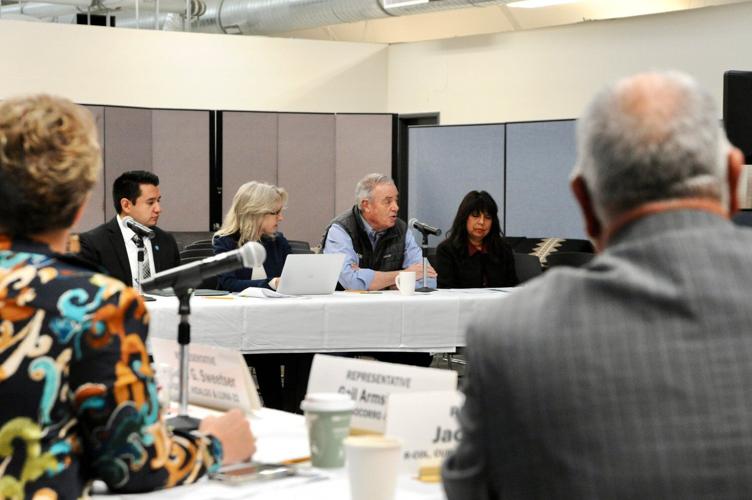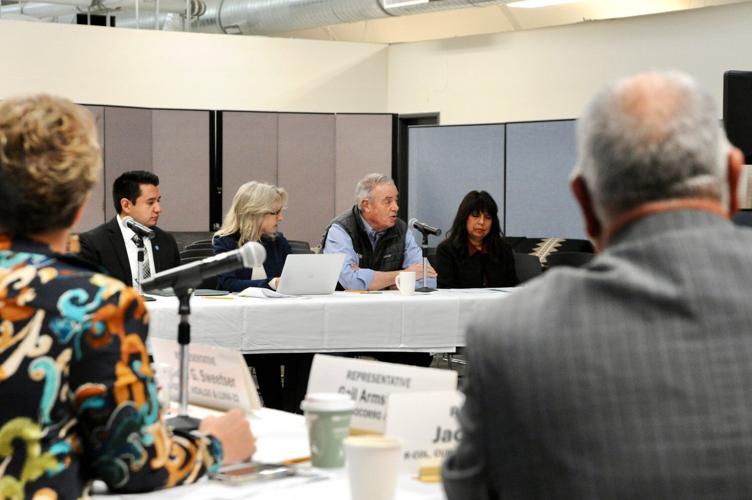Local government officials established three funding priorities for Taos County communities in their welcoming remarks to the interim Legislative Finance Committee last week: housing, transportation and watershed protection. The interim committee gathered in Taos Ski Valley for three days of meetings last month.
A Legislative Finance Committee factsheet indicates that Taos County, with a population of 32,593 people, is upside down when it comes to median household income versus the cost of housing. Only 57 percent of renters can afford average rent prices in Taos County, and just 9.4 percent of renters can afford a median-priced home, according to the committee's analysis.
At around $40,000, median annual household income in Taos County is $11,000 less than the median income across New Mexico; and Taos County households earn over a third less than the average American household, which makes about $62,000 annually. Meanwhile, the median home price in Taos County has long been well above the state average. And with Taos County home prices increasing at a rapid clip between 2018 and today, the cost of buying a home in Taos County — which in 2018 only just exceeded the average cost of buying a home in the United States — now far exceeds the national average.
"It sounds to me like most of these homes are purchased by folks outside the area," said Patricia Lundstrom, interim committee chair and District 9 state representative, noting that Taos County has "a high unemployment rate" and asking: "Who is buying these homes?"
Taos Mayor Pascual Maestas told Lundstrom and her fellow committee members that, according to a survey completed during the pandemic, "40 percent of our homes are vacant" or occupied only part of the year.
"Many of them are short-term rentals," Maestas added. "We just got our data back just a few weeks ago that in the county there are 1,400 short-term rentals and in the town of Taos about 138. So, many of them are second homes or vacant homes."
Taos' 2022-26 Infrastructure Capital Improvement Plan is a funding wish-list that serves to guide legislators' capital outlay choices. It also provides a roadmap for other funding sources, and makes "affordable housing" the town's No.1 infrastructure priority. But it's also the only item — with a price tag of $2.85 million — among the municipality's top five infrastructure projects that has yet to receive any funding.
Newly-formed nonprofit Taos Housing Partnership estimates that a prospective Taos homebuyer with an annual income of $39,350 (the median household income in Taos from 2016-2020 was $41,973, according the the U.S. Census Bureau) could afford a mortgage on a home costing $157,200.
But the average market price for a two-bedroom house over the past year-to-date, however, was $434,251, according to the partnership, signifying a gap of $277,051, which puts home ownership out of reach of most Taos residents. In response, the housing partnership says it "will sponsor development that is priced below market rates and provide mortgage assistance" in order to lessen the affordability gap. The group wants to see 500 new homes or housing units either in place or underway "in the first five years of its operation."
Jennifer Lopez, a consultant engaged by the group, told the Taos News that existing-but-unfinished housing projects within Taos could help produce as many as 180 new homes in the near future.
"At last one private developer is trying to negotiate 81 units below market, and the town of Taos is activating the Chamisa Verde subdivision," Lopez said. "I think it's ambitious, but we have ambitious leaders."
Affordable housing projects like Chamisa Verde can struggle to attract buyers in rural New Mexico, either because the target income bracket for buyers is too narrow to draw sufficient interest, or because the prospect of building and owning a home — even with the benefit of state and federal subsidies and affordable mortgage programs — is too daunting.
"We're looking to incentivize builders to construct a different housing product, to build new starter homes," Lopez said, adding that not all of the 500 dwellings proposed by the Taos Housing Partnership will be new. "And we're going to look at providing financial literacy programs at the same time we get this pipeline of housing together. It's such a dynamic environment right now, because there is a lot of ARPA funding, and state funds at this time to do this."
"Housing is the foundation of everything else we might talk about," said AnJanette Brush, District 4 commissioner and vice chair of the Taos County Commission. Brush then moved on to public safety and transportation needs in Taos County, which spurred a discussion regarding the volunteer nature of rural EMTs and firefighters across New Mexico.
"In rural areas like ours, our first responders are often volunteers; volunteer firefighters and EMS are also public safety," Brush said. "It might be time to consider how we need to support them more."
Taos, Taos County, Red River and Questa have paid fire departments, but the bulk of the county relies on 13 volunteer fire departments — which have faced recruitment challenges for years.
District 6 state Sen. Bobby Gonzales, who sits on the Senate Finance Committee, agreed with Brush. He told his fellow interim committee members that "maybe our remote, rural EMTs should be paid," adding, "it may be too much to ask someone to give that much of their life for free."
Taos County Fire Marshal James Hampton said he hopes Gonzales's comment is an indication of changes to come.
"Without meaningful change, we face a difficult task ahead of us, and we need to be proactive in how we look to the future," Hampton told the Taos News. "It has become so difficult to recruit new members. And the ones we do get have jobs and lives and families that they have to tend to alongside their duties as firefighters. They often miss family events, holidays and many other things to help their communities.
"We need to recognize that the volunteer fire service that we have been so accustomed to is dwindling and there are just not many people coming in to replace the aging members we still have," Hampton added. "If we don’t do something and do it soon, we may see volunteer fire departments just cannot respond in the capacity that our communities need and deserve."
Chris Stagg, Village of Taos Ski Valley councilor and a Taos Ski Valley, Inc. vice president, told legislators about the ski corporation's plans for a gondola that would alleviate traffic congestion between the resort's two basins and added that the village is "preparing to work with the [North Central Regional Transit District] "to ramp up the electric bus service between Taos and Taos Ski Valley — and throughout the county, really.
"That's one of the things that's really important to us," he said, a comment that he backed up this week during a village council meeting. Stagg and his fellow councilors voted unanimously to enter into an agreement with the North Central Regional Transit District (RTD) to bring daily bus service between Taos and Taos Ski Valley during the winter season. The agreement calls for 100 days of daily service during peak ski season, as well as 29 days of night service. Eventually, the plan is for RTD to transition to electric-powered buses.
The additional $19,500 annual cost of the expanded "Green Service Expansion" between the Ski Valley and the Sagebrush Inn will be shared by Taos, Taos County and the Village of Taos Ski Valley, which still bears the largest cost-share of the three governments. The total annual cost of the route will be $150,000.
Stagg also told legislators that the ski valley is part of a larger initiative that is focused on restoring and preserving the watershed within which the resort and municipality sits, as well as other watersheds in north-central New Mexico.
"All of us are very active in the Rio Grande Water Fund, and that's a forest health restoration project throughout Northern New Mexico. And 600,000 acres I think is the total of that. And we've done here in Taos Ski Valley about 400 acres of forest [restoration and wildfire mitigation] this summer, so we're working diligently if you look around the forest, you'll see places where things have been cleaned up and thinned out in order to reduce the fire danger," Stagg said.















(2) comments
There are several solutions to the housing crisis here in Taos County. We need to look at long held beliefs and structure of Capitalism. Decisions should be made around how the majority of residents will be affected. "Development at what cost?" Should be one of the questions asked along with, "How are we measuring our health and welfare? Is it based solely on the amount of so-called development projects?
One solution regarding the housing issue would be to create a tax on vacation homes and homes where occupancy is less than 6 months per year. Apply that tax to building quality, affordable housing. Of course, the argument would be, 'I paid for my house and I'll use it whenever I want' and within our Capitalistic society, that argument holds water but, what if we started thinking and acting differently? What if, we reconstructed our society on fairness and equity again, for the majority of the population?
Until we start asking these questions, there will be no parity and with no parity change for the better will not come anytime soon.
100% with you on the tax the short term rentals in the county. I post this same comment every time I see an article touching on the cost of housing. It is a simply, acrsso the board effective way to raise millions of dollars for a Taos Housing Autority that can help fund and mange both rentals and deed restricted for purchase housing for locals who cannot afford market rate housing. There are similar programs in Colorado ski towns like Aspen that are well established and are a template for getting this under control before it reaches a point where workers have no housing here.
Welcome to the discussion.
Log In
All comment authors MUST use their real names. Posts that cannot be ascribed to a real person
will not be moderated.
Keep it Clean. Please avoid obscene, vulgar, lewd, racist or sexually-oriented language.
PLEASE TURN OFF YOUR CAPS LOCK.
Don't Threaten. Threats of harming another person will not be tolerated.
Be Truthful. Don't knowingly lie about anyone or anything.
Be Nice. No racism, sexism or any sort of -ism that is degrading to another person.
Be Proactive. Use the 'Report' link on each comment to let us know of abusive posts.
Share with Us. We'd love to hear eyewitness accounts, the history behind an article.